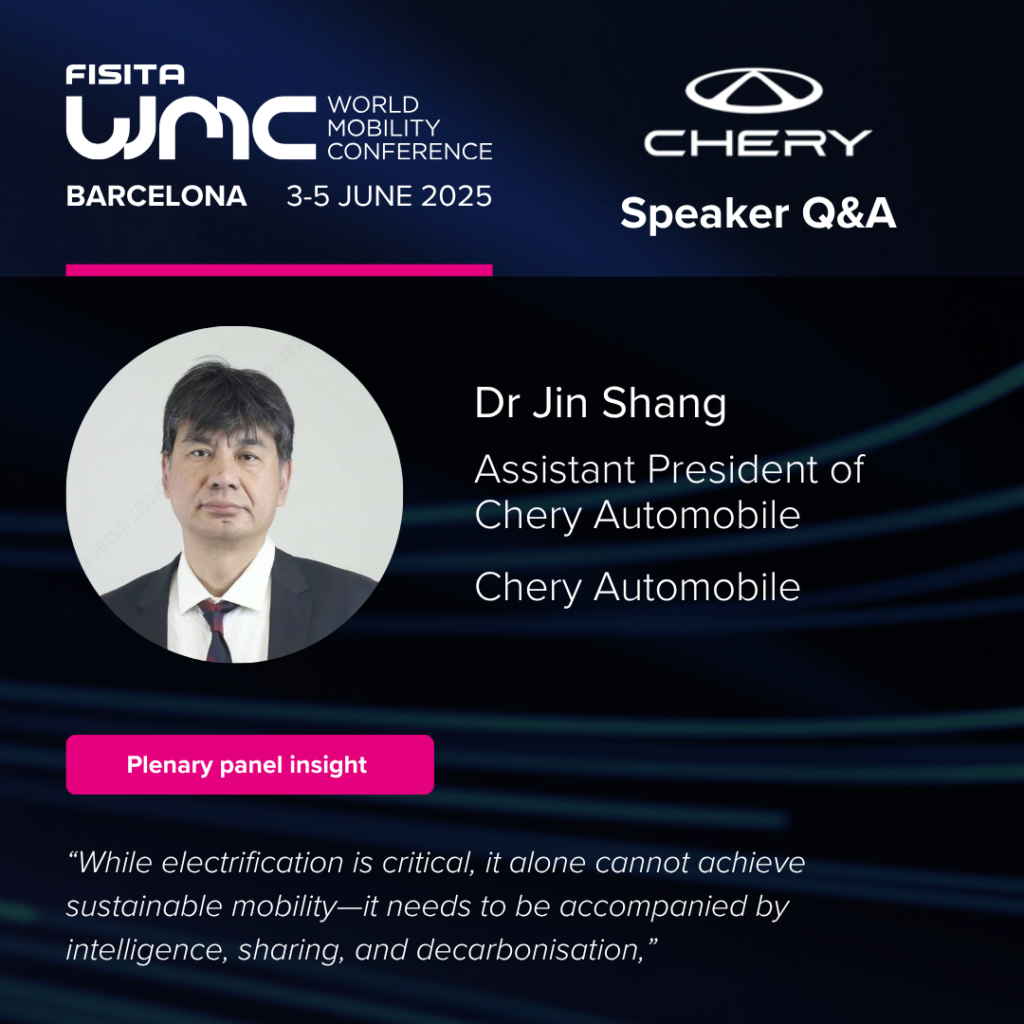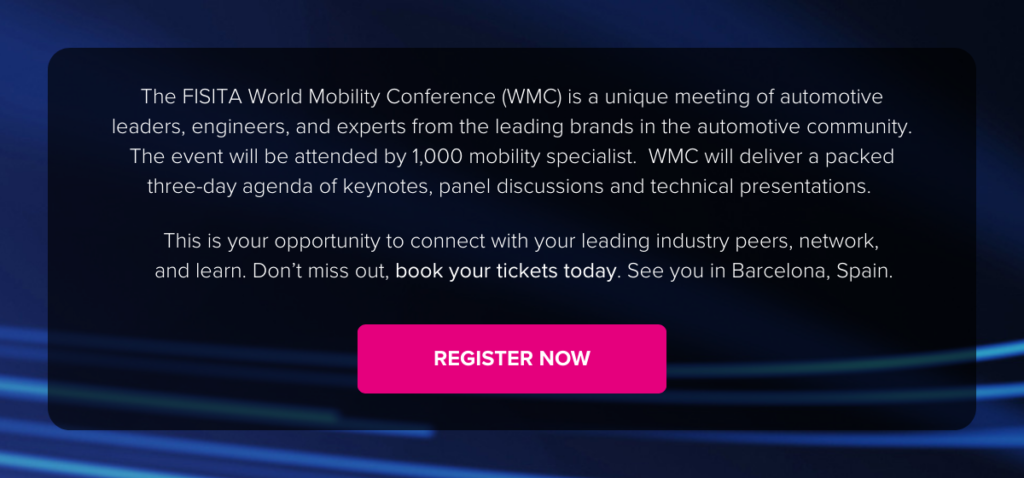Dr Jin Shang, CEO and CTO at Kaiyang Laboratory and Assistant to CEO, Chery Automobile, talks to FISITA CTO Martin Kahl about disruption in the automotive industry
“While electrification is critical, it alone cannot achieve sustainable mobility—it needs to be accompanied by intelligence, sharing, and decarbonisation,” says Dr Jin Shang, CEO and CTO at Kaiyang Laboratory and Assistant to the CEO at Chery Automobile.
Dr Shang’s keynote at the FISITA World Mobility Conference in June 2025 will present Chery’s perspectives on safety, automated driving, and sustainability. He will also touch on Chery’s overseas operations, including its joint venture with Barcelona-based EBRO-EV Motors to produce EBRO vehicles at the former Nissan Barcelona factory.
In conversation with FISITA, Dr Shang shares his views on sustainable mobility and the development of circular economy principles in the global automotive industry.
Automotive is one of the most disruptive and disrupted industries; from your perspective, is sustainability being sufficiently embraced as a business strategy, or still seen as a compliance cost—and how do you see this changing?
Many automakers, constrained by traditional supply chains and short-term cost pressures, still treat sustainable development as little more than a regulatory checkbox. However, forward-thinking automotive leaders increasingly view sustainability as a strategic imperative—not just a compliance cost.
Leading companies are driving innovation through sustained technological investment, such as developing ultra-efficient vehicles via high-performance powertrains, advanced thermal management, and aerodynamic optimisation; integrating recycled materials early in the design phase; and strengthening carbon footprint analysis and ESG frameworks to embed sustainability into corporate strategy—turning it into a lever for innovation, cost savings (e.g., energy-neutral factories), and competitive branding.
By combining the domestic appliance sector’s recycling precision with automotive’s cross-industry scalability, a truly systemic circular economy can emerge—one where design, recovery, and regeneration are seamlessly interconnected
As investor priorities change, such as ESG-driven capital allocation, as consumer preferences evolve, with younger generations favouring ethical brands, and as regulations are introduced, the strategic value of sustainability will only grow, and its tangible returns will become undeniable.
Electrification is just one way in which automakers can achieve cleaner mobility; what else should the industry consider in the quest to reduce the environmental impact of mobility?
While electrification is critical, it alone cannot achieve sustainable mobility—it needs to be accompanied by intelligence, sharing, and decarbonisation.
In terms of intelligence, smart technologies reduce congestion and emissions by optimising vehicle operations. Examples include intelligent navigation using real-time traffic data to shorten routes, cutting fuel consumption by 15 to 20 percent, and driving assistance systems that enable smoother acceleration and deceleration, minimising energy waste from abrupt stops.
Sharing refers to maximising resource utilisation. Shared mobility slashes emissions and space demands; one shared vehicle replaces four to six private cars, drastically reducing greenhouse gases. In Bremen, Germany, for example, car-sharing avoids 1,600 tons of CO₂ per year; and car-sharing means less space is required for parking—indeed, according to data from Shanghai Hongqiao Transportation Hub, car-sharing can reduce required parking space by 58 percent, freeing urban land for greener uses.
The third factor, decarbonisation, addresses emissions beyond the tailpipe. That includes things like lightweight materials such as recyclable composites, which cut vehicle weight by ten to 15 percent, improving efficiency. It also includes vehicle-to-grid (V2G) technology, which stabilises energy grids and boosts renewable electricity usage; and zero-carbon factories and low-carbon manufacturing which gain momentum among policymakers and automakers. Looking ahead, energy diversity will be key. Electrification must coexist with alternative solutions like green hydrogen, which is already proving viable for long-haul heavy-duty transport.
Circular economy is becoming an accepted business practice in the automotive industry, but it’s far from maturity. How easy is it to build circularity into mass-market business models and into mainstream manufacturing processes and operations?
Building a circular economy in mass-market automotive is not just aspirational—it’s already operational. China’s battery recycling ecosystem exemplifies this progress. A systematic recycling process sees end-of-life EVs entering dismantling facilities, where batteries are extracted and sent to certified recyclers. Batteries with residual capacity are tested, sorted, and repurposed for applications like construction machinery or low-speed EVs; and non-reusable batteries are broken down into raw materials such as lithium and cobalt, through purification, then fed back into battery production.
While China’s battery recycling chain is mature, profitability models for some segments remain under exploration. Standardisation and regulations are also critical to ensure scalability and environmental integrity.
Europe’s remanufacturing ecosystem for internal combustion engine components such as transmissions and engines, offers a proven template for circular economies, combining industrial expertise with regulatory frameworks.
Forward-thinking automotive leaders increasingly view sustainability as a strategic imperative—not just a compliance cost
By integrating these models, the automotive industry can turn waste into value—closing the loop from production to recycling.
What can the automotive industry learn from other industries about sustainability and circular economy? And what can other industries learn from automotive?
The automotive industry can accelerate its circular economy transition by adopting proven strategies from the home appliance sector, while also offering valuable lessons for other industries through its own innovations.
The home appliance industry has established a closed-loop model with four key pillars. The first, green design, involves modular architectures and at least 30 percent post-consumer recycled (PCR) plastics in new products; the second, smart recycling, involves digital platforms with a high level of coverage, at 83 percent, and hybrid reverse logistics or community collection systems. AI-powered sorting, with 99.7 percent accuracy, achieves precious metal recovery rates of 98.5 percent, and high-value regeneration, with 99.9 percent recovery of pure PCR plastics and greater than 95 percent rare earth element reuse.
While learning from others, the automotive sector also provides transferable innovations, notably in terms of industrial collaboration and technology integration. On the former, EV-energy sector partnerships enable V2G networks and graded battery storage systems. And on the latter, AI and large-scale models optimise resource flows and enable new circular business models, such as predictive maintenance, and material tracking.
This session aims to inspire not just dialogue, but actionable partnerships—because the future of mobility demands nothing less
By combining the domestic appliance sector’s recycling precision with automotive’s cross-industry scalability, a truly systemic circular economy can emerge—one where design, recovery, and regeneration are seamlessly interconnected.
You’re a keynote speaker at the FISITA World Mobility Conference. What will be your key message to delegates?
My plenary keynote will explore the transformative power of global innovation strategies in shaping the future of the automotive industry, alongside spotlighting Chery Automobile’s Kaiyang Lab as a paradigm of cutting-edge R&D. I’ll present some concrete examples to illustrate how Kaiyang Lab is driving progress in intelligent platforms and AI integration for next-generation mobility solutions. And I will discuss low-carbon transformation across manufacturing and product lifecycles; new ecosystem development, fostering cross-industry collaboration, and exceptional product capabilities that redefine user experiences.
A core theme will be the imperative for global open collaboration, and the need to break down silos to accelerate sustainable innovation. I will call on industry peers, policymakers, and academia to co-create a shared framework for progress, ensuring the automotive sector remains a force for equitable and environmentally responsible advancement.
The key takeaways for attendees will be actionable insights into integrating innovation across technology, sustainability, and business models. Attendees will hear firsthand case studies from Kaiyang Lab’s pioneering work in AI, decarbonisation, and ecosystem building. I’ll present a collaborative vision for uniting global stakeholders to address industry-wide challenges. This session aims to inspire not just dialogue, but actionable partnerships—because the future of mobility demands nothing less.

